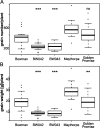HvDep1 Is a Positive Regulator of Culm Elongation and Grain Size in Barley and Impacts Yield in an Environment-Dependent Manner
- PMID: 28005988
- PMCID: PMC5179111
- DOI: 10.1371/journal.pone.0168924
HvDep1 Is a Positive Regulator of Culm Elongation and Grain Size in Barley and Impacts Yield in an Environment-Dependent Manner
Abstract
Heterotrimeric G proteins are intracellular membrane-attached signal transducers involved in various cellular processes in both plants and animals. They consist of three subunits denoted as α, β and γ. The γ-subunits of the so-called AGG3 type, which comprise a transmembrane domain, are exclusively found in plants. In model species, these proteins have been shown to participate in the control of plant height, branching and seed size and could therefore impact the harvestable yield of various crop plants. Whether AGG3-type γ-subunits influence yield in temperate cereals like barley and wheat remains unknown. Using a transgenic complementation approach, we show here that the Scottish malting barley cultivar (cv.) Golden Promise carries a loss-of-function mutation in HvDep1, an AGG3-type subunit encoding gene that positively regulates culm elongation and seed size in barley. Somewhat intriguingly, agronomic field data collected over a 12-year period reveals that the HvDep1 loss-of-function mutation in cv. Golden Promise has the potential to confer either a significant increase or decrease in harvestable yield depending on the environment. Our results confirm the role of AGG3-type subunit-encoding genes in shaping plant architecture, but interestingly also indicate that the impact HvDep1 has on yield in barley is both genotypically and environmentally sensitive. This may explain why widespread exploitation of variation in AGG3-type subunit-encoding genes has not occurred in temperate cereals while in rice the DEP1 locus is widely exploited to improve harvestable yield.
Conflict of interest statement
Authors TW, CD, AP, MH, and IB are affiliated with Carlsberg Research Laboratory, which is part of Carlsberg Breweries. This does not alter our adherence to PLOS ONE policies on sharing data and materials. The authors have no competing interest to declare.
Figures






References
-
- Badr A, Muller K, Schafer-Pregl R, El Rabey H, Effgen S, Ibrahim HH, et al. On the origin and domestication history of Barley (Hordeum vulgare). Mol Biol Evol. 2000;17(4):499–510. - PubMed
-
- Baik B-K, Ullrich SE. Barley for food: Characteristics, improvement, and renewed interest. J Cereal Sci. 2008;48:233–42.
MeSH terms
Substances
LinkOut - more resources
Full Text Sources
Other Literature Sources

